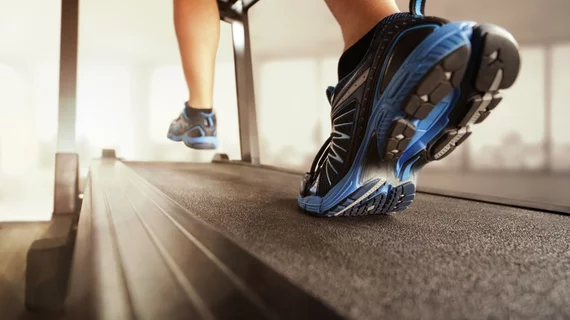A randomized trial published April 24 in JAMA suggests patients with lower-extremity peripheral artery disease (PAD) can’t be expected to improve walking performance on their own, even with the aid of wearable activity trackers and telephone coaching sessions.
Home-based walking exercise has a current class 2A recommendation for these patients based on the results of three randomized trials, wrote lead author Mary M. McDermott, MD, and colleagues. However, those trials included periodic visits to medical centers throughout the intervention, while this one featured eight months of only telephone-based communication with an exercise coach.
McDermott and coauthors studied 200 PAD patients—mean age 70.2; 52.5 percent women—who were randomized to receive usual care or provided with activity trackers and telephone coaching sessions.
The researchers found the exercise intervention didn’t significantly improve patients’ distance on a six-minute walking test. In fact, they fared slightly worse than those receiving usual care—gaining 5.5 meters from baseline compared to 14.4 meters for the control group. Patients given wearable devices also scored worse on a pain interference metric and tallied similar scores on questionnaires evaluating quality of life, physical functioning, mobility and satisfaction with social roles.
“These results do not support home-based exercise interventions of wearable devices and telephone counseling without periodic onsite visits to improve walking performance in patients with PAD,” McDermott et al. wrote.
For the first month of the nine-month intervention, the patients with activity trackers met clinicians once a week at the medical center, but after that they received only periodic check-ups and coaching sessions via telephone. The control patients didn’t receive any coaching, but were contacted once a month to collect data on adverse events and asked every three months about their physical activity and walking frequency.
The authors highlighted several potential explanations for why the exercise intervention didn’t work in this study:
- Remote coaching is likely “less potent” than in-person visits for behavioral changes.
- The wearables measured activity throughout the day, not specific episodes of intense walking exercise which would be expected to lead to better endurance gains.
- The periodic telephone coaching sessions decreased in frequency as the intervention progressed.
- Patients with PAD who are interested in home-based exercise may be less motivated than participants who commit to travel for supervised exercise.
McDermott and colleagues said their trial shouldn’t be used to discount home-based exercise for patients with PAD; it merely suggests that occasional in-person visits remain a crucial part of those strategies.
“Behavioral interventions in randomized clinical trials that included periodic visits to a medical center throughout the intervention achieved large meaningful improvements in the 6-minute walk distance among patients with PAD,” they wrote. “Furthermore, these prior home-based exercise interventions achieved greater improvement in the 6-minute walk distance than supervised exercise interventions.”

